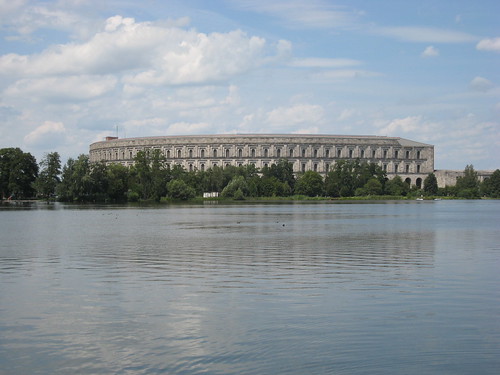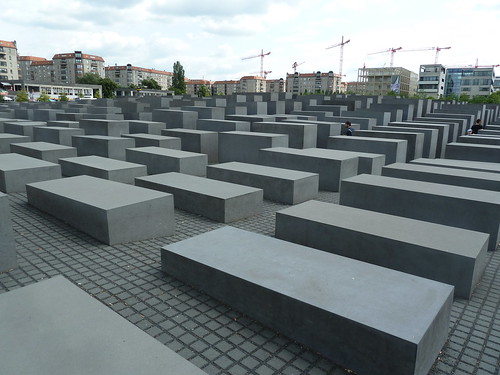Germany: Reconciling with the Past

Dachau Concentration Camp, 2007
Have you heard of the concept of a “second country?” I heard this recently: The country in which we live is our first country, but we usually feel a connection to a second place. It could be the country that we or our ancestors came from. Maybe it’s a place we have visited. Or it could just be a place we read about or saw in a movie.
My second country is Germany. On November 15, 1980, I landed at Frankfurt’s Rhein-Main Airport and spent the next three years living there while serving in the U.S. Army. I lived in two major cities, first Stuttgart, then Nurnberg, and traveled throughout. Most of the time I was with other Americans but I spent enough time “on the economy” to develop a feel for the place unlike the experience of a typical vacation trip. Germany is also where I met my wife, Roxane, who was stationed there as well.
We’ve gone back twice: in 2007, joined by our son Andrew, we returned to the places where we had been stationed and re-visited other places that had left a positive impression on us. In 2013, Roxane and I spent a week in Berlin, a place that would have been exceedingly difficult for us to visit during the Cold War of the early 1980s. I hope there are more visits to Germany in our future.

former Merrell Barracks in 2007
One of the most interesting aspects of going back was to see how things had changed in the 25 years since we had lived there. Merrell Barracks, the base I was assigned to in Nurnberg, had become the German government’s Office of Refugee Resettlement. And Flak Kaserne in Ludwigsburg, Roxane’s home for three years, was abandoned, padlocked and overgrown with weeds.

Flak Kaserne, Ludwigsburg, Germany in 2007
Perhaps the biggest and most substantial change I noted was the attitude of Germans towards their involvement in World War II. In 1980, no one really spoke about it, except for 60+ year old men after several liters of Lowenbrau at the local beer fest. And while the concept of “political correctness” had yet to be acknowledged, what they muttered was off the charts by that measure. A few places, like the former German Army barracks at which I worked, still had walls pockmarked by American .50 cal. rounds from 1944. In Nurnberg, the great marble reviewing stand at the Nazi Party Rally Grounds was intact and in good repair except for the swastika that had been dynamited off the roof by American Army combat engineers after the city’s capture.

Dachau Memorial Site in 2007
Then there was Dachau, the concentration camp on the outskirts of Munich. When I visited it in 1982, the remains of the camp were still there. Some of the original buildings stood although you could only view them from the outside. There may have been a few signs but no detailed labels telling you what you were looking at. There was a newer building, something like a Quonset hut, that held some photos and artifacts. But rather than an interpretive museum, it was more like a storehouse for items that had been donated from a variety of people and entities. Regardless of the lack of museum formalities, I was still overwhelmed by the somberness of the place and the powerful knowledge of the enormous evil that had occurred there.
What I found upon my return to Dachau in 2007 was startling – in a good way. The boarded-up buildings from 1982 were now open to the public. There were plenty of multilingual signs and labels. A large vacant area in the middle of the site now held replicas of the foundations of the inmate barracks buildings. There were so many of them that it gave you a better sense of the scale of this concentration camp.
The large administration building, closed in 1982 like everything else, was now a first-class museum. It did not sugarcoat the story of Nazism in Germany. Far from it: the story told in that museum was one of evil and horror that took place at that very site. It was a story told by the descendants of those who had committed the terrible acts, or who turned a blind eye and did nothing to stop them.

Nazi Party Rally Grounds, Nurnberg, Germany, 2007

Kongresshalle (site of museum), Nurnberg, 2007
We found a similar museum in Nurnberg on the grounds of the Nazi Party Rally Grounds. In 1982-83, I passed by this site nearly everyday – it was on the course of our morning PT run – and it was always locked up. In 2007, this same mammoth building had become the Dokumentationszentrum (Documentation Center), a museum that explored the causes and consequences of Nazi Germany, especially the city of Nurnberg’s substantial role in Nazism. The museum was very somber with dark gray floor, cement ceiling and red brick walls. You moved from room to room and station to station, pressing the corresponding numbers on the audio device to hear commentary.

Eagle’s Nest in 2007
A few days later, we were in Salzburg, Austria. Just back across the German border was Berchtesgaden and the Kehlstein Haus (Eagle’s Nest) which was a residence used by Hitler before and during World War II. The Americans occupied this area at the end of the war and renamed a hotel that once housed members of the Nazi regime the General Walker which was for the exclusive use of members of the US Military and their families. (Henry Kissinger once said “the Russians seized the key cities; the Americans seized the key ski resorts.”). In fact, I had stayed at the General Walker Hotel a couple of times in the early 1980s.
When we visited in 2007, the Eagle’s Nest was still there, attracting as many visitors as ever, but the General Walker Hotel was gone. In its place was another Dokumentation Center which told the story of Hitler’s rise to power, the strategy and tactics he used and the war and destruction wrought by the Nazi regime. Some of it was content covered at the Nurnberg museum, but new stuff included information about low or no interest loans for families that were intended to allow women to stay home and have children (they got awards Iron Crosses of bronze, silver and gold depending on how many children they had). Also, getting women out of the workforce lowered the unemployment rate.
The story of the post war life of the site was interesting, too. Much of the Nazi construction was destroyed except for the Eagle’s Nest house which was built to impress foreign visitors and presented to Hitler on his 50th birthday. The General Walker American Hotel closed in 1996 and was torn down in 2000. It was replaced by this museum. There seems to be an ongoing concern that the Eagle’s Nest not turn into a pilgrimage site for Nazi sympathizers.

Berlin Holocaust Memorial – 2013
A few years later in Berlin we visited the Holocaust Memorial which opened in 2005. The Memorial is a field of large gray cement rectangles of uniform size and shape but differing heights. The pathways between these blocks were paved with cobblestones and descended and rose. There were no words or markings anywhere. The design seemed part of a trend towards horizontal memorials such as the Vietnam Memorial and the Pentagon 9/11 Memorial. The museum itself was underground. Climbing down some stairs you pass through metal detectors into a lobby. Then there were several rooms that told the story, very bluntly, of the Holocaust through words and pictures. Then there were family and individual stories that really personalized what happened. Especially moving were lit floor panels in an otherwise dark room. Each had an excerpt from a diary, letter or note of one who was murdered – which is the word the exhibit uses repeatedly, to powerful effect.
The contrast between Germany’s public reckoning with the Nazi era in 1980 and in 2007 was striking. At the earlier time, society seemed to acknowledge it, but only grudgingly, like a very embarrassing episode in one’s past that would rather be forgotten. In 2007, the country confronted its evil past head-on. These exhibits weren’t cookie cutter replicas put up to pacify an external audience. They were a clear public acknowledgement of what had happened with no revisionism, no feel-good explanations, no celebration of the heroism of the ordinary soldier, nothing remotely positive other than the honesty of coming to terms with the past as a way of ensuring it not happen again.
I came away from my recent visits to Germany impressed with how the country was reconciling the Nazi era of the past with the country’s future self-image. And I couldn’t help but compare that with America’s continuing unwillingness to acknowledge the evils of slavery and the harms that it caused in an honest and straightforward way.